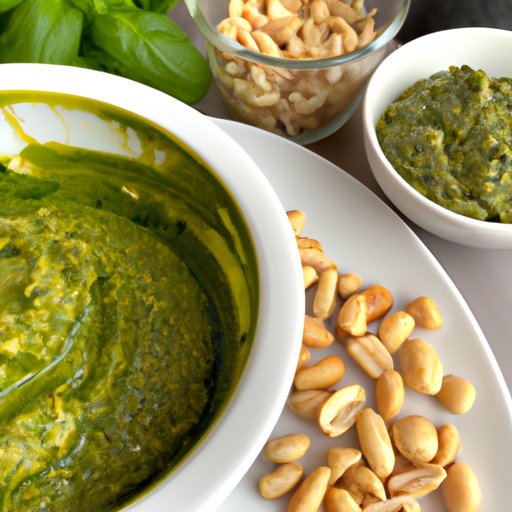Introduction
Pesto is a popular Italian sauce made from fresh basil, pine nuts, garlic, olive oil, and Parmesan cheese. It has become a staple in many kitchens around the world, as it is easy to make and adds flavor to any dish. But is pesto actually healthy? In this article, we will explore the nutritional benefits and health risks associated with pesto, as well as how to incorporate it into a balanced diet.

Analyzing the Nutritional Benefits of Pesto
The nutritional benefits of pesto vary depending on the type of pesto you are using. Traditional pesto is high in fat and calories, but it does provide some essential micronutrients. For example, one tablespoon of traditional pesto contains:
- 2 grams of protein
- 3 grams of carbohydrates
- 6 grams of fat
- 1 gram of fiber
In addition to macronutrients, pesto also contains various vitamins and minerals. According to research published in the Journal of Food Composition and Analysis, “the most abundant mineral components were calcium, magnesium, phosphorus, potassium, sodium, zinc, and iron” (Espín et al., 2019). Pesto is also rich in plant-based compounds, such as antioxidants, which can help protect against disease.

Examining the Health Risks Associated with Pesto
Although pesto provides numerous nutritional benefits, there are some potential health risks associated with it. The most common allergen found in pesto is pine nuts, which may cause an allergic reaction in some individuals. Additionally, pesto is often high in sodium and fat, so it should be consumed in moderation if you are trying to watch your sodium or fat intake.

Exploring the Different Types of Pesto and Their Health Effects
Traditional pesto is made with Parmesan cheese, which is high in sodium and saturated fat. However, there are other varieties of pesto that can be healthier options. For example, vegan pesto is made without cheese and can be lower in fat and calories. Low-fat pesto is another option, as it typically contains less fat than traditional pesto. Additionally, you can make your own pesto at home with fresh ingredients, which can reduce the amount of sodium and fat in the dish.
Investigating the Ingredients in Pesto and How They Impact Health
When it comes to making pesto, it is important to consider the ingredients. Olive oil is a key ingredient in pesto, as it adds flavor and helps bring the other ingredients together. Olive oil is high in healthy fats, such as monounsaturated fatty acids, which can help reduce cholesterol levels and decrease the risk of heart disease. Garlic is another key ingredient in pesto and has been linked to numerous health benefits, such as reducing inflammation and improving blood flow. Basil is rich in antioxidants and has anti-inflammatory properties, while pine nuts provide healthy fats and protein.
Parmesan cheese is also used in traditional pesto recipes, but it is high in saturated fat and sodium. If you want to reduce the amount of fat and sodium in your pesto, you can swap out the Parmesan cheese for nutritional yeast or low-fat cheese. Additionally, you can use less cheese or omit it altogether.
Comparing Pesto to Other Sauces and Dips for Optimal Health
Pesto is often compared to other sauces and dips, such as hummus, salsa, and guacamole. Hummus is a great alternative to pesto, as it is made from chickpeas and tahini, which are both rich in protein and fiber. Similarly, salsa is a healthier option than pesto, as it is lower in fat and calories. Additionally, guacamole is a great dip to pair with vegetables, as it is a good source of healthy fats and vitamins.
Creating Healthy Pesto Recipes for a Balanced Diet
Incorporating pesto into a healthy diet can be easy and delicious. To reduce fat and sodium, try using low-fat or vegan pesto. Here are some healthy pesto recipes to get you started:
- Pesto Chicken Salad: Combine cooked chicken, roasted vegetables, and low-fat pesto for a flavorful salad.
- Pesto Zucchini Noodles: Swap out regular pasta for zucchini noodles and top with vegan pesto for a light and healthy meal.
- Pesto Cauliflower Rice: Make cauliflower rice and mix in pesto for a quick and easy side dish.
Conclusion
Overall, pesto can be part of a healthy diet when consumed in moderation. While it does contain some essential vitamins and minerals, it is also high in fat and sodium. Therefore, it is important to choose the right type of pesto and use it sparingly. Additionally, it is important to compare pesto to other sauces and dips to ensure you are getting the most nutrition out of your meals. With the right ingredients and recipes, you can easily incorporate pesto into a balanced diet.
(Note: Is this article not meeting your expectations? Do you have knowledge or insights to share? Unlock new opportunities and expand your reach by joining our authors team. Click Registration to join us and share your expertise with our readers.)
